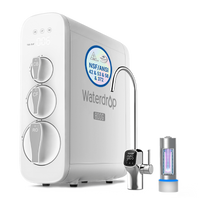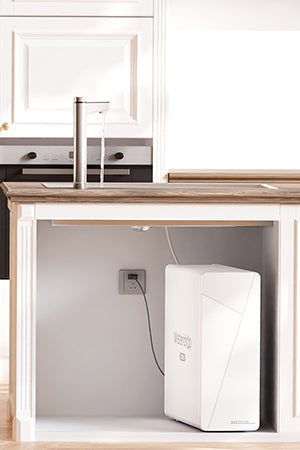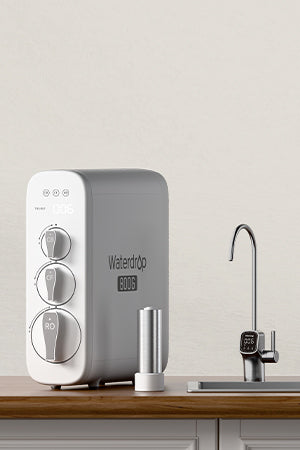Pour les humains, l'eau est source de vie, et cela s'applique également aux animaux de compagnie. Nous savons facilement quelle quantité d'eau nous devons boire chaque jour, mais de nombreux propriétaires d'animaux ignorent la quantité d'eau dont leurs chiens ont besoin.
En réalité, les chiens peuvent sauter des repas pendant trois jours, mais ils ne peuvent pas vivre un seul jour sans boire. Le manque d'eau entraîne une stagnation digestive, une perte d'appétit et une diminution de la résistance aux maladies. Dans le blog d'aujourd'hui, nous répondrons à certaines questions que vous devriez connaître en tant que propriétaire d'animal.
Pourquoi l'eau est importante pour les chiens
L'eau est un nutriment essentiel pour les animaux de compagnie et constitue également le composant le plus important de leur organisme. Les animaux peuvent survivre en perdant la totalité de leur masse grasse ou la moitié de leurs protéines, mais ils risquent la mort s'ils perdent 10 % de leur eau.
Pourcentage d'eau dans les animaux de compagnie
La quantité d'eau présente dans le corps d'un animal est d'environ 50 à 70 %. Sa répartition dans les organes et tissus est variable. La teneur en eau des muscles est d'environ 72 à 78 %, celle du sang d'environ 80 % et celle des tissus adipeux inférieure à 10 %.
L'eau du corps est divisée par la membrane cellulaire en liquide intracellulaire, qui représente environ les deux tiers de l'eau totale du corps, et en liquide extracellulaire, qui représente environ un tiers.
Le rôle de l'eau
L'eau comme composant principal
La majeure partie de l'eau présente dans le corps de l'animal est combinée à des protéines pour former un colloïde, ce qui confère aux cellules tissulaires une certaine forme, dureté et élasticité.
L'eau comme solvant idéal
L'eau est un solvant idéal pour décomposer les nutriments et autres éléments essentiels du corps animal. Elle est indispensable au métabolisme de l'animal. La digestion, l'absorption, le fonctionnement et l'élimination de divers nutriments dans l'organisme doivent être dissous dans l'eau.
L'eau comme milieu
Grâce à l'action des enzymes dans l'organisme animal, l'eau participe à de nombreuses réactions chimiques telles que l'hydrolyse, l'oxydoréduction, la synthèse de matière organique et la respiration cellulaire. Elle joue un rôle essentiel dans le bon fonctionnement des systèmes de l'organisme.
Régulateur de température corporelle
L'eau peut stocker l'énergie thermique, la conduire rapidement et l'évaporer, ce qui est bénéfique pour la régulation de la température corporelle des animaux. L'évaporation de l'eau pour dissiper la chaleur est particulièrement importante pour les animaux dotés de glandes sudoripares.
Lubrification
L'eau est présente sous forme de fluide tissulaire dans la capsule articulaire du corps animal, dans les cavités corporelles et entre les différents organes. Elle peut réduire la friction entre les articulations et les organes et jouer un rôle de lubrifiant.
Quelle quantité d’eau un chien doit-il boire par jour ?
Maintenant que vous avez appris l’importance de boire de l’eau pour les chiens, quelle quantité d’eau devons-nous donner aux chiens chaque jour ?
Il n'existe pas de chiffre précis applicable à tous les chiens. Les différentes races, les différents âges, les différents poids et la proportion de croquettes consommée influenceront la quantité d'eau dont un chien a besoin chaque jour.
Par exemple, les chiots doivent boire environ 50 à 70 ml d'eau par kilo de poids corporel par jour ; les chiens adultes doivent boire environ 30 à 60 ml d'eau par kilo de poids corporel par jour. Si votre chien pèse 10 kg, la quantité recommandée est d'environ 59 à 650 ml par jour.
En règle générale, les besoins en eau des animaux domestiques sont proportionnels à la nourriture qu'ils consomment. Chaque livre de croquettes nécessite 1 à 2 litres d'eau potable, et le ratio eau/nourriture sèche des chiens et chats adultes est d'environ 3 pour 1.
Si vous êtes propriétaire d'un chien et que vous n'avez pas la moindre idée du volume d'eau, rappelez-vous simplement que 60 ml d'eau correspondent à environ 60 ml. Ou, plus pratique encore, utilisez des récipients gradués pour surveiller la quantité d'eau que votre chien boit chaque jour.
Pourquoi mon chien boit-il autant d’eau ?
Une consommation excessive de protéines ou de glucides par les animaux de compagnie augmente leur consommation d'eau. Par exemple, après avoir consommé des aliments riches en sel, la quantité d'eau potable disponible pour les chiens est multipliée par quatre. Les besoins en eau des animaux de compagnie varient également selon la race, l'état physiologique, le type d'alimentation et les facteurs environnementaux.
Cependant, des maladies comme le diabète, l'insuffisance rénale ou l'hyperfonctionnement des glandes surrénales peuvent également entraîner une consommation excessive d'eau. Si vous constatez que ce problème persiste, emmenez votre chien chez le vétérinaire et consultez-le immédiatement.
Pour une chienne non stérilisée qui commence à boire beaucoup d'eau, même en été, il faut être conscient du risque de pyomètre, qui s'accompagne généralement d'une perte d'appétit, d'une augmentation du débit urinaire et d'un écoulement vulvaire.
Comment inciter votre chien à boire de l’eau ?
Si votre chien ne parvient pas à atteindre la quantité d’eau quotidienne nécessaire, voici quelques moyens de faire en sorte qu’il tombe amoureux de l’eau potable.
Changement de comportement
Tant que votre chien boit de l'eau, encouragez-le et donnez-lui certaines récompenses matérielles
Changement stratégique
Placez le bol d'eau près de sa nourriture, de son panier et de ses lieux de jeu habituels. Ajoutez des points d'eau et placez-les dans des endroits où les chiens aiment se tenir ou où ils se font remarquer.
Changement de liquide
Utilisez de l’eau courante fraîche ou de l’eau filtrée pour nourrir votre chien.
Il est très fréquent que les chiens ne finissent pas toute l'eau de leur récipient. Il est donc important de la changer régulièrement, et non lorsqu'elle est vide. En effet, contrairement à l'eau courante, l'eau d'un récipient favorise la prolifération des bactéries, et le chien est également vulnérable aux insectes après avoir bu de l'eau contaminée.
Pourquoi devriez-vous commencer à filtrer l'eau de votre chien
Si possible, donnez à votre chien de l'eau filtrée. Ne croyez pas qu'il soit acceptable pour un chien de boire directement l'eau du robinet. Avec le vieillissement du réseau d'eau municipal, l'eau du robinet présente un risque élevé de contenir des impuretés et des bactéries. Il est donc déconseillé aux chiens de boire directement l'eau du robinet.
Si vous possédez un système de filtration d'eau à domicile, il vous suffit de prélever de l'eau fraîche au robinet. Le système d'osmose inverse Waterdrop D6 est idéal pour les propriétaires d'animaux. Il assure une excellente filtration en éliminant les bactéries, les virus et autres contaminants courants de l'eau. En améliorant le goût de l'eau, les animaux sont plus susceptibles de boire une eau filtrée fraîche et savoureuse que l'eau du robinet non filtrée.
Un autre point fort du système est l'écran intelligent du robinet, qui permet de surveiller la qualité de l'eau et l'état du filtre en temps réel. Vous avez ainsi l'assurance que l'eau que boit votre animal est saine et sécurisée.
Changement de goût
Si aucune des tactiques ci-dessus ne s'avère efficace, au lieu de donner directement de l'eau à votre chien, remplacez-la par de la soupe au poulet, au bœuf ou à la viande. Augmentez progressivement la proportion d'eau, comme pour les chiots qui changent de nourriture.









































































